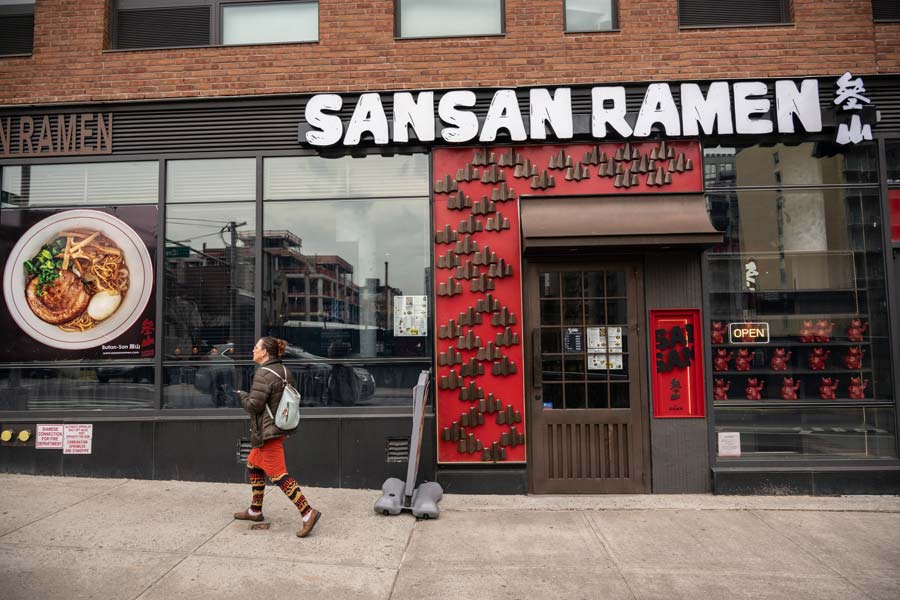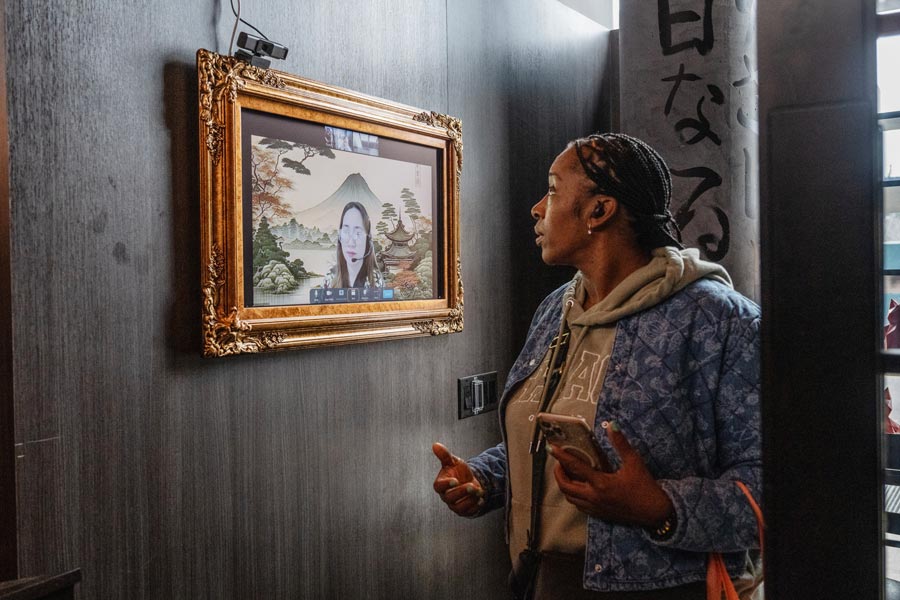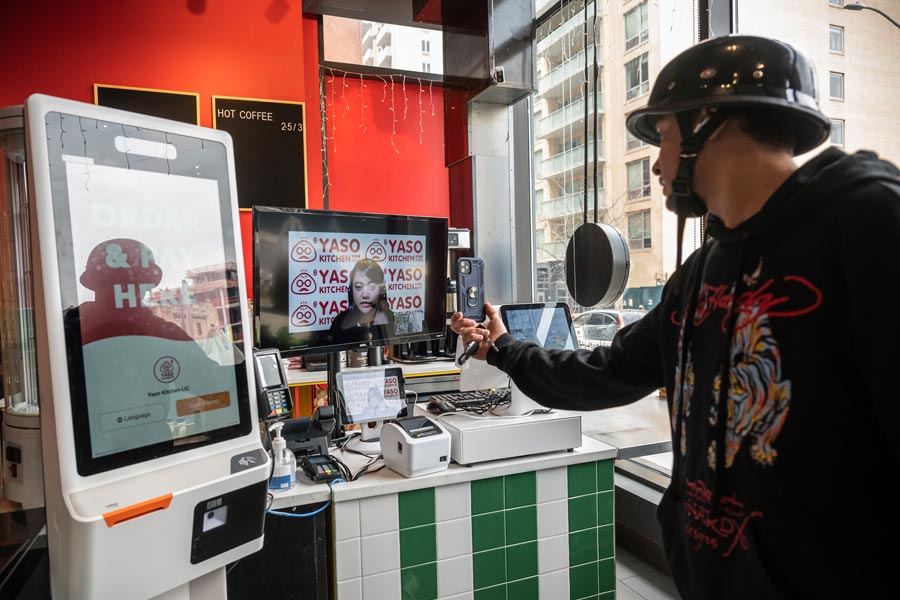At Sansan Chicken in Long Island City, Queens, the cashier beamed a wide smile and recommended the fried chicken sandwich.
Or maybe she suggested the tonkotsu — it was hard to tell, because the internet connection from her home in the Philippines was spotty.
Romy, who declined to give her last name, is one of 12 virtual assistants greeting customers at a handful of restaurants in New York City, from halfway across the world.
The virtual hosts could be the vanguard of a rapidly changing restaurant industry, as small-business owners seek relief from rising commercial rents and high inflation. Others see a model ripe for abuse: The remote workers are paid $3 an hour, according to their management company, while the minimum wage in the city is $16.
The workers, all based in the Philippines and projected onto flat-screen monitors via Zoom, are summoned when an often unwitting customer approaches. Despite a 12-hour time difference with the New York lunch crowd, they offer warm greetings, explain the menu and beckon guests inside.

An outlet of SanSan Ramen, a chain that has incorporated remote greeters and cashiers at some of its restaurants, in New York, April 4, 2024. A handful of New York City restaurants are experimenting with virtual staff members, who greet customers on a screen via Zoom from the Philippines. Victor J. Blue/The New York Times
But skeptical customers said they were not eager to join this particular Zoom meeting.
“You hear ‘hello’ and you say, ‘What the hell is that?’” Shania Ortiz, 25, recalled of a recent trip to Sansan Ramen, a neighboring Japanese restaurant that had a gold-framed, flat-screen monitor set up in the foyer with a surveillance camera trained on guests. “I never engage,” she said.
The service is the brainchild of Chi Zhang, 34, the founder of Happy Cashier, a virtual-assistant company that was thrust into the spotlight last week, when a social media post about the overseas workers went viral.
He was caught off guard. The program has been quietly tested since October, but the company’s website has not yet been set up. The technology is already available in stores in Queens, Manhattan and Jersey City, New Jersey, including at Sansan Ramen, its sister store, Sansan Chicken, and Yaso Kitchen, a Chinese soup dumpling spot. Two other Chinese restaurants using the service on Long Island asked not to be named, he said.
Zhang is a former owner of Yaso Tangbao, a Shanghainese restaurant in Brooklyn that closed during the coronavirus pandemic. He said the experience reinforced the idea that restaurants were being squeezed by high rents and inflation, and that a virtual-assistant model, somewhat akin to that employed by overseas call centers, could help maximize small retail spaces and improve store efficiency.
When the virtual assistants are not helping customers, they coordinate food delivery orders, take phone calls and oversee the restaurants’ online review pages, Zhang said. They can take food orders, but they can’t manage cash transactions.

Rosy Tang, a manager at a SanSan Chicken, who said that the cost savings and space savings of having the virtual assistants could allow her to add a small coffee stall to the restaurant, in New York, April 4, 2024. A handful of New York City restaurants are experimenting with virtual staff members, who greet customers on a screen via Zoom from the Philippines. Victor J. Blue/The New York Times
The workers are employees of Happy Cashier, not the restaurants. And Zhang said that their $3-an-hour wage was roughly double what similar roles paid in the Philippines.
Tipping policy is set by the restaurants, he said, with one giving its virtual greeters 30% of the pooled total each day.
The restaurant industry has long been an entry point for immigrants, and a hotbed for labor violations such as wage theft.
But the Happy Cashier model is legal and minimum wage laws extend only to workers “who are physically present within the state’s geographical limits,” according to a spokesperson for the New York State Department of Labor.
Zhang said he expected to quickly scale up by placing virtual assistants in more than 100 restaurants in the state by the end of the year.
The prospect is alarming, said Teófilo Reyes, the chief of staff at Restaurant Opportunities Centers United, a nonprofit labor group that has pushed for a higher minimum wage in New York.
“The fact that they have found a way to outsource work to another country is extremely troubling, because it’s going to dramatically put downward pressure on wages in the industry,” he said.
The fast-food workforce is already shrinking, and new technology could further transform the industry, said Jonathan Bowles, the executive director of the Center for an Urban Future, a public policy think tank.
Fast-food restaurants in New York City had an average of 8.5 employees in 2022, he said, down from 9.23 in 2019, before the pandemic.
Virtual assistants have become common in customer service and corporate settings, but are rare in the hands-on restaurant business.
One recent exception came from Freshii, a Canadian restaurant brand that faced a backlash in 2022 over claims of outsourcing jobs, after partnering with a virtual cashier business called Percy.
Zhang said his business was different. “It’s a service; we are providing a tool. It’s up to them how to use this,” he said of his restaurant clients.
Brett Goldstein, 33, a founder of an artificial intelligence company who made the viral post about the virtual workers, said some commenters had described the model as dystopian while many others had been intrigued.
At the Sansan Chicken in Manhattan’s East Village, Rosy Tang, 30, a manager, praised the service.
“This is a way for small businesses to survive,” she said, adding that the cost and space savings it provided could allow her to add a small coffee stall to the store.
In practice, however, quirks with the model abound.
At the Sansan Chicken in Queens, the virtual assistant couldn’t help a reporter order a sandwich without cheese on a touch pad menu. The assistant said the reporter should order from the in-person staff members at the Sansan Ramen next door, which shares a kitchen with the chicken restaurant.
Will Jang, 30, an associate at Goldman Sachs, had lunch on Wednesday at the Yaso Kitchen in Jersey City — and completely ignored his virtual host, Amber.
“I thought it was some advertisement,” like the prerecorded videos in taxi cabs, he said.

Candace King, a customer, reacts to a remote cashier as she appears on a screen at an outlet of the SanSan Ramen restaurant, in New York, April 4, 2024. A handful of New York City restaurants are experimenting with virtual staff members, who greet customers on a screen via Zoom from the Philippines. Victor J. Blue/The New York Times
Amber, who did not give her last name, took it in stride. After studying business administration in college, she said, she worked in person at a fast-food restaurant. She started this virtual job three months ago.
“It’s my first time to work in a work-from-home setup,” she said in front of a virtual backdrop emblazoned with mustachioed cartoon dumplings.
When asked where home was, she demurred.
“I’m sorry, I cannot share any more personal details with you,” she said. “Can I take your order?”
The New York Times










